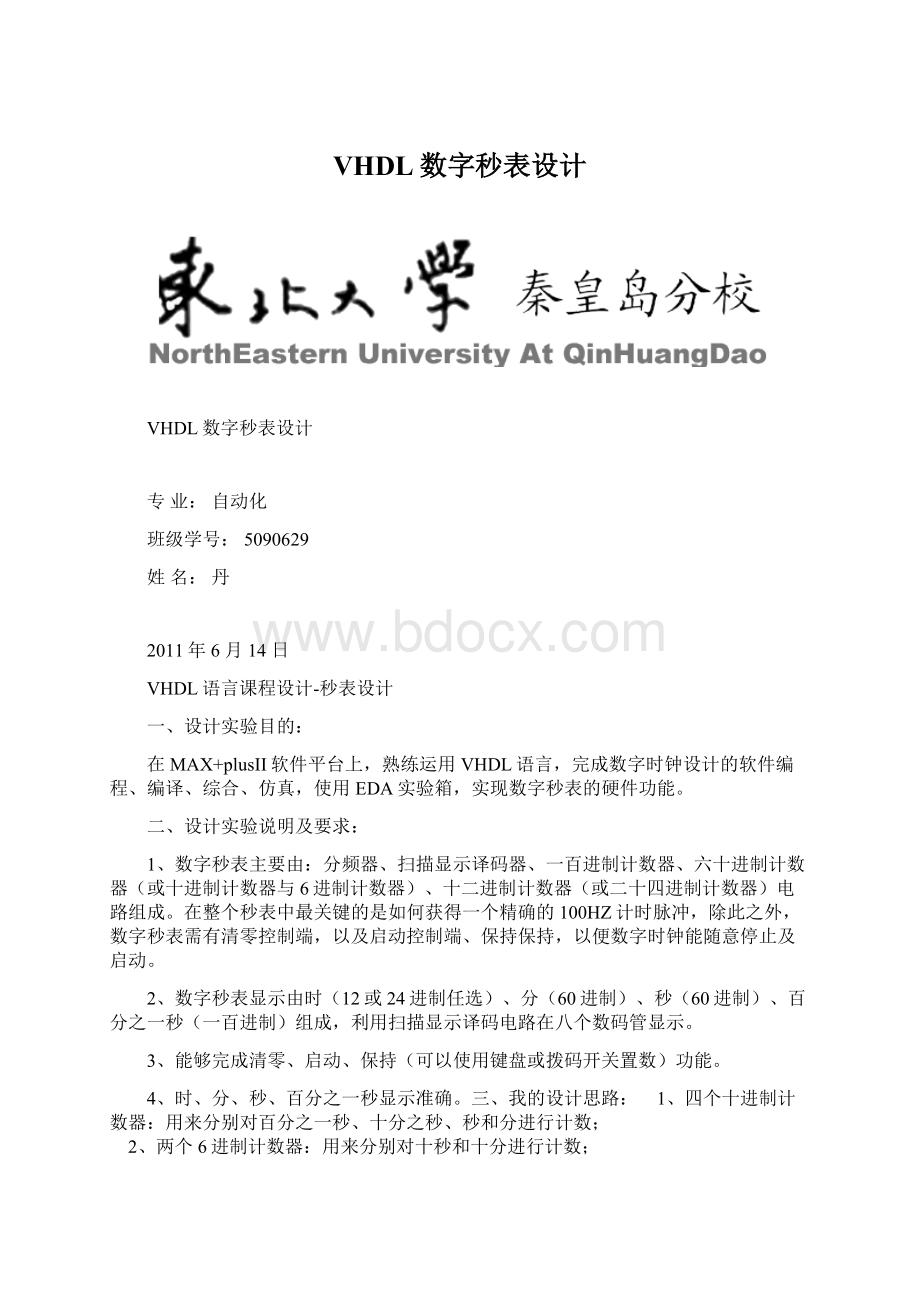VHDL数字秒表设计.docx
《VHDL数字秒表设计.docx》由会员分享,可在线阅读,更多相关《VHDL数字秒表设计.docx(10页珍藏版)》请在冰豆网上搜索。

VHDL数字秒表设计
VHDL数字秒表设计
专业:
自动化
班级学号:
5090629
姓名:
丹
2011年6月14日
VHDL语言课程设计-秒表设计
一、设计实验目的:
在MAX+plusII软件平台上,熟练运用VHDL语言,完成数字时钟设计的软件编程、编译、综合、仿真,使用EDA实验箱,实现数字秒表的硬件功能。
二、设计实验说明及要求:
1、数字秒表主要由:
分频器、扫描显示译码器、一百进制计数器、六十进制计数器(或十进制计数器与6进制计数器)、十二进制计数器(或二十四进制计数器)电路组成。
在整个秒表中最关键的是如何获得一个精确的100HZ计时脉冲,除此之外,数字秒表需有清零控制端,以及启动控制端、保持保持,以便数字时钟能随意停止及启动。
2、数字秒表显示由时(12或24进制任选)、分(60进制)、秒(60进制)、百分之一秒(一百进制)组成,利用扫描显示译码电路在八个数码管显示。
3、能够完成清零、启动、保持(可以使用键盘或拨码开关置数)功能。
4、时、分、秒、百分之一秒显示准确。
三、我的设计思路:
1、四个十进制计数器:
用来分别对百分之一秒、十分之秒、秒和分进行计数;
2、两个6进制计数器:
用来分别对十秒和十分进行计数;
3、一个24进制计数器,用来对小时进行计数; 3、分频率器:
用来产生100Hz的计数脉冲;
4、显示译码器:
完成对显示译码的控制。
四、设计过程:
1.分频器:
由10MHz变为100Hz,10MHz的周期是10的(-7)次方,而100Hz的周期是10的(-2)次方,而且方波是高低相间,只有高电平有效,所以100Hz的周期需要取一半,即0.02秒,这样算出的分频倍数就是50000
分频器代码:
将10MHz脉冲变成100Hz
程序:
libraryieee;
useieee.std_logic_1164.all;
entityfenpinis
port(clr,clk:
inbit;q:
bufferbit);
endfenpin;
architectureaoffenpinis
signalcounter:
integerrange0to49999;
begin
process(clr,clk)
begin
if(clk='1'andclk'event)then ifclr='1'then
counter<=0;
elsifcounter=49999then
counter<=0;
q<=notq;
else
counter<=counter+1;
endif;
endif;
endprocess;
enda;
分频器的仿真图:
2.十进制计数器:
原理为加法计数器,从0加到9,计到10个数时由cout进位
程序:
libraryieee;
useieee.std_logic_1164.all;
useieee.std_logic_unsigned.all;
entityc10is
port(clr,start,clk:
inbit;
cout:
outbit;
daout:
outstd_logic_vector(3downto0));
endc10;,
architectureaofc10is
signaltemp:
std_logic_vector(3downto0);
begin
daout<=temp;
process(clk,clr)
begin
ifclr='1'then
temp<="0000";
cout<='0';
elsif(clk'eventandclk='1')then
ifstart='1'then
iftemp>="1001"then
temp<="0000";
cout<='1';
else
temp<=temp+1; cout<='0';
endif;
endif;
endif;
endprocess;
enda;
十进制计数器仿真图:
3.六进制计数器:
原理为加法计数器,从0加到5计到第六个数时由cout进位。
程序:
libraryieee;
useieee.std_logic_1164.all;
useieee.std_logic_unsigned.all;
entityc6is
port(clr,start,clk:
inbit;
daout:
outstd_logic_vector(3downto0);
cout:
outstd_logic);
endc6;
architectureaofc6is
signaltemp:
std_logic_vector(3downto0);
begin
daout<=temp; process(clk,clr)
begin
ifclr='1'then
temp<="0000";
cout<='0';
elsif(clk'eventandclk='1')then
ifstart='1'then
iftemp>="0101"then
temp<="0000";
cout<='1';
else
temp<=temp+1; cout<='0';
endif;
endif;
endif;
endprocess;
enda;
6进制计数器仿真图:
4、二十四进制计数器
采用一个二进制的计数器和一个四进制的计数器相结合到一起,低位从0到9,到9向高位进一,当低位计到四,高位计到2,进行进位输出,即每二十四个数进行一次进位输出
libraryieee;
useieee.std_logic_1164.all;
useieee.std_logic_unsigned.all;
entityc24is
port(clr,start,clk:
instd_logic;
hour1,hour0:
outstd_logic_vector(3downto0));
endc24;
architectureaofc24is
begin
process(clr,clk)
variablet1,t0:
std_logic_vector(3downto0);
begin
ifclr='1'thent0:
="0000";t1:
="0000";
elsifclk'eventandclk='1'then
ifstart='1'then
ift1="0010"andt0="0011"
thent1:
="0000";
t0:
="0000";
elsift0<"1001"thent0:
=t0+1;
elset0:
="0000";
t1:
=t1+1;
endif;
endif;
endif;
hour1<=t1;
hour0<=t0;
endprocess;
enda;
24进制计数器仿真图:
5.数据选择和数码管选择模块代码:
其功能是选择计数端口来的数据,当相应的数据到来时数据选择器数据后输数给数码管,并由数码管显示。
八个数码管分别显示小时,分钟,秒,百分秒
libraryieee;
useieee.std_logic_1164.all;
useieee.std_logic_unsigned.all;
entityseltimeis
port(clk:
inbit;
dain0,dain1,dain2,dain3,dain4,dain5,dain6,dain7:
instd_logic_vector(3downto0);
sel:
outstd_logic_vector(2downto0);
daout:
outstd_logic_vector(3downto0));
endseltime;
architectureaofseltimeis
signaltemp:
integerrange0to7;
begin
process(clk)
begin
if(clk='1'andclk'event)then
iftemp=7thentemp<=0;
elsetemp<=temp+1;
endif;
casetempis
when0=>sel<="000";daout<=dain0;
when1=>sel<="001";daout<=dain1;
when2=>sel<="";daout<=dain2;
when3=>sel<="011";daout<=dain3;
when4=>sel<="100";daout<=dain4;
when5=>sel<="101";daout<=dain5;
when6=>sel<="110";daout<=dain6;
when7=>sel<="111";daout<=dain7;
endcase;
endif;
endprocess;
enda;
仿真图:
5.数码管驱动模块代码:
数码管驱动电路,驱动数码管发光。
libraryieee;
useieee.std_logic_1164.all;
entitydeledis
port(num:
instd_logic_vector(3downto0);
led:
outstd_logic_vector(6downto0));
enddeled;
architectureaofdeledis
begin
process(num)
begin
casenumis
when"0000"=>led<="0111111";-----------3FH
when"0001"=>led<="0000110";-----------06H
when"0010"=>led<="1011011";-----------5BH
when"0011"=>led<="1001111";-----------4FH
when"0100"=>led<="1100110";-----------66H
when"0101"=>led<="1101101";-----------6DH
when"0110"=>led<="1111101";-----------7DH
when"0111"=>led<="0100111";-----------27H
when"1000"=>led<="1111111";-----------7FH
when"1001"=>led<="1101111";-----------6FH
whenothers=>led<="0000000";-----------00H
endcase;
endprocess;
enda;
五、秒表原理图
六:
实验总结
通过本次的课程设计,我初步了解了vhdl语言的编程思想,以及利用EDA软件进行电子电路设计的方法,通过对一个课题的分析,将实验的容进行分块解读,具体到每一个模块的具体作用,然后将各个功能的模块通过连线进行总体的电路实现,也可以通过Vhdl语言对各个模块进行组合,然后需要在程序编译成功的基础上,安装硬件,将程序下载到具体的芯片上进行硬件的实现。
通过整个实验的完成,我从老师和同学那里学到了更多关于vhdl编程,仿真以及硬件实现的知识,自己以前模糊不清的地方也通过此次的课程设计了解清楚了,并且通过这次课程设计,我也锻炼了独立思考,独立操作的能力,虽然对于vhdl语言的应用我还很生疏,但是此次的课程设计却让我学到了很多,也对这门语言有了更深的理解,对eda软件的使用有了更多的体会。